1. What are the historical origins of cognitive neuroscience?
2. Differentiate cognitive neuroscience and cognitive neuropsychology.
3. What methods are used to research the brain?
4. How is the nervous system organized?
5. What evidence is there for localization of function in the brain?
6. What does split-brain syndrome reveal about the brain?
7. Describe how the brain can change. What are the implications for brain training?
The Case of Phineas Gage
• 25-year-old railroad construction foreman for Rutland and Burland Railroad
• in Vermont on September 13, 1848, an accident sent a tamping iron through his ____
• regained consciousness shortly after; walked to nearest doctor
• lost left eye, but was still able-bodied and intelligent; lived another 13 years
• some reports claimed his _________ changed profoundly: disregarded social conventions, used profanity, lacked social responsibility
• however, these reports are controversial, and may have been exaggerated
• Ratiu & colleagues (2004):
- created computer-generated 3-D reconstruction of Gage’s skull
- concluded there was damage to left _____________ and prefrontal cortex
- purported changes in Gage’s behaviour parallel those in patients with damage to the orbitofrontal cortex and amygdala
- considered to be “the index case for personality change due to frontal lobe damage” and “the historical beginnings of the study of the __________ basis of behavior”
Alexander Luria (b.1902-d.1977)
- psychologist wrote about two now-famous case studies:
• a journalist with apparently unlimited ______ (The mind of a mnemonist: A little book about a vast memory, 1968)
• a man who whose brain injury abolished his ability to read, write, and speak (The man with a shattered world: The history of a brain wound, 1972)
- related brain areas to psychological functions
- created the field of _______________
Cognitive neuroscience: investigates the neural mechanisms underlying all cognitive processes
- attempts to link mind to _____
- can all cognitive functions be _________?
- how does this aid understanding?
(Cognitive) neuropsychology: also focuses on mental processes, but with an emphasis on studying the cognitive effects of brain injury or neurological illness, and applying the results to models of normal cognitive functioning
• ________ observations:
- measure and record effects of brain damage/diseases
- relate damaged area to lost/disrupted function
• manipulation:
- __________ stimulation of brain (ESB): map effects to brain regions using electrodes (Penfield & Jasper, 1954)
- _______: surgical destruction of tissue
e.g., frontal lobotomy severs connection to frontal lobe; reduces seizures
- TMS (transcranial ________ stimulation):
• magnetic coil placed beside head
• pulse ________ neural activity; like temporary lesion
• relates disrupted function to location
• record electrical activity:
- ____________________ (EEG) measures event-related potentials (ERPs) produced by large numbers of neurons
- intra/extracellular recordings: measure activity of a single neuron, using microelectrode
• brain imaging:
PET (________ ________ tomography):
- take radioactive form of glucose
- X-rays cause positron to be emitted
- shows metabolic activity
fMRI (__________ magnetic resonance imaging):
- hemoglobin (which carries oxygen in the blood) contains an iron atom that has magnetic properties
- strong magnetic field (e.g., 3 Tesla) aligns magnetic molecules
- radio wave pulse disorients them
- upon realignment, protons emit radio waves which can be measured quickly
- shows metabolic activity
___ (magnetoencephalography)
- similar to EEG, but detects magnetic fields
- uses arrays of SQUIDs (superconducting quantum interference devices)
- signals are weak, but MEG is faster than other methods
- shows neural activity
___________ technique:
- brain imaging compares activity between two conditions
- activity produced in control (or baseline) condition is subtracted from the activity produced in experimental condition
- result shows the difference due to experimental manipulation
Pros & Cons of Brain Imaging:
![]() can correlate active area with function
can correlate active area with function
![]() can only _________ active area with function
can only _________ active area with function
![]() applications range from
promising (neurodiagnosis)...
applications range from
promising (neurodiagnosis)...
![]() ...to dodgy (neuromarketing,
neurolaw, even neuropolitics)
...to dodgy (neuromarketing,
neurolaw, even neuropolitics)
![]() naïve adults and
neuroscience students were more likely (than experts) to be convinced by evidence containing (irrelevant) neuroscience ______: “Brain scans indicate...” (Weisberg et al., 2008)
naïve adults and
neuroscience students were more likely (than experts) to be convinced by evidence containing (irrelevant) neuroscience ______: “Brain scans indicate...” (Weisberg et al., 2008)
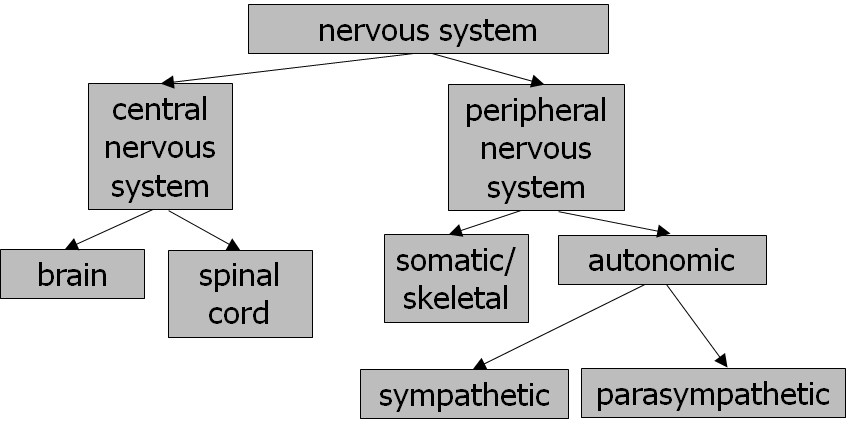
• _________: self-governing; generally involuntary and unconscious
• spinal cord ![]() brainstem
brainstem
• hindbrain:
- __________: planning, timing, and coordination of voluntary movements; control of ballistic movement
- ____: sleep stages, arousal, consciousness
- _______ oblongata: cardiorespiratory function
• midbrain:
- superior & inferior _________: process visual & auditory information, respectively
- _________ _________: attention, sleep & arousal, reflexes
- also motor function
• forebrain:
- ________: “relay station” for incoming sensory information
- ____________: mediator between brain & endocrine (hormone) system; regulates bodily functioning
- limbic system:
• ___________: implicated in some kinds of memories
• ________: plays a role in anger & aggression, forming emotional memories; stimulation produces fear
• ______: involved in anger & fear responses; specifically, produces “relief”
- basal ganglia: controlling voluntary movements
- cerebral cortex
- responsible for “higher-order” functioning
- structure:
• 3-4 mm thick
• ~30 billion neurons (~300 trillion synapses)
• total surface area 2,500 cm2 (2.5 ft2)
• comprises 80% of brain mass
• _____ (Greek for “circle”): convoluted ridge between anatomical grooves in the cerebral cortex; these wrinkles increase surface area
• ______ (Latin for “groove,” “furrow,” or “trench”): small groove in the cortex (vs. fissure: deeper; divides lobes)
• 2 hemispheres; 4 lobes
- functions:
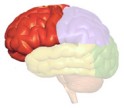 |
• _______ lobe: contains motor cortex; also involved in planning, coordinating, controlling, and executing behavior; emotional control; judgment |
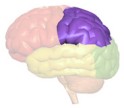 |
• ________ lobe: contains somatosensory cortex; also integrates sensory data from different modalities, handles spatial information, sense of “self” |
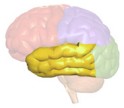 |
• ________ lobe contains auditory cortex; plays role in auditory processing, language, vision, memory formation; object categorization |
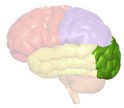 |
• _________ lobe contains visual cortex; handles visuospatial processing, colour, motion perception |
Franz Josef Gall (b.1758-d.1828):
- discovered differences between grey matter (neuron cell bodies) and white matter (myelinated axons)
- “cranioscopy” came to be known as “__________”
- assumed that personality traits/abilities ![]() _____, and brain
_____, and brain ![]() _____
_____
- approx. 95% of population has language areas localized in left hemisphere
- _______: language difficulty due to brain damage
• ______: loss of ability to name objects
- damage in left ________ lobe
- can be specific (e.g., cannot name colours, animals, or fingers)
• _______ aphasia (Paul Broca, 1865):
- a.k.a. motor or expressive aphasia
- severely impaired ______; patient could only say “tan”
- problems forming sentences (spoken, written, and signed--but can draw and ____)
- comprehension relatively normal, but may be affected
- ___________ speech: nouns & verbs, but no function words
- caused by damage in left frontal lobe
• __________ aphasia (Carl Wernicke, 1874):
- a.k.a. sensory or receptive aphasia
- primarily a _____________ problem
- lack of awareness that speech is incomprehensible; comprehension impaired in nonverbal tasks (e.g., pointing)
- sentences may be fluent and grammatical, but gibberish: “____ _____”, neologisms
- caused by damage in left ________ lobe
• __________ aphasia:
- a.k.a. associative aphasia
- can comprehend language
- have fluent speech, but show paraphasic errors (e.g., dropping syllables)
- cannot ______ heard words; oral reading may also be poor
- caused by damage to arcuate fasciculus (connects Wernicke’s area to Broca’s area)
• _______ gyrus:
- recodes visual information into auditory form
- damage causes breakdown in reading
- aphasias imply distinct processing units that work ________
• reading: visual cortex ![]() angular gyrus
angular gyrus ![]() Wernicke’s
Wernicke’s
• listening: auditory cortex ![]() Wernicke’s (content)
Wernicke’s (content) ![]() Broca’s (syntax)
Broca’s (syntax)
• speaking: Wernicke’s (content) ![]() Broca’s (syntax)
Broca’s (syntax) ![]() motor cortex
motor cortex
- brain has many contralateral connections
e.g., object in right visual field ![]() left occipital lobe (& vice-versa for object in left visual field)
left occipital lobe (& vice-versa for object in left visual field)
e.g., left side of brain damaged ![]() loss of function on right side
loss of function on right side
- information shared across hemispheres via ______ ________: about 200 million axons connecting the two cerebral hemispheres
- when corpus callosum is surgically severed to treat extreme epilepsy, the result is split-brain syndrome: two ___________ brain hemispheres
- studied by Roger Sperry (awarded 1981 Nobel Prize)
• left hemisphere: generally specialized for ______ and analysis
• right hemisphere: generally better at _________ tasks: idenfying faces, handling emotions, perceptual/spatial tasks
- definition: creation of new neurons in an adult brain from adult ____ cells (neurons themselves do not reproduce)
- through much of the 20th century, neurogenesis was believed not to exist
- was observed in brains of adult animals in the 1960s
- evidence in adult humans found, starting in late 1990s
- these new neurons have been implicated in memory formation
e.g., new hippocampal neurons exhibit long-term changes in response to experience during the first two weeks of “life” (Ge et al., 2007)
- definition: modifications to structure and function of neural ________ due to changes in neurons and their connections
- generally accepted to occur in childhood:
• neurons and connections initially proliferate (until about 8 months), probably forming ______ connections
• this is followed by _______: synapses are eliminated (due to lack of use?)
• the number of synapses in an adult brain is about 40% less than the peak in childhood
e.g., evidence suggests pruning is complete in the visual cortex by age 10, but continues in the frontal cortex until adolescence
- experience-dependent plasticity in the visual cortex:
• with normal input, the visual cortex will develop to process visual information from the eyes
• animals deprived of visual experience will be functionally _____
• animals selectively exposed to certain visual stimuli (e.g., vertical lines only) will develop vision sensitive to vertical lines (and insensitive to horizontal lines)
• these effects obtain in response to visual deprivation during a ________ period: time during which particular visual experience is required to develop normal vision
- neuroplasticity was initially believed to occur only in young brains; however, evidence has accumulated to show that connections can continue to change in adult brains throughout the lifespan
• visual cortex of blind people can change to respond to sound or other sensory input
• body maps in the somatosensory cortex of adult monkeys changed to respond to adjacent fingers when one digit was amputated
• (these changes may be due to brain remapping, or to an enhancement of existing pathways)
• fMRI studies have demonstrated changes in patterns of brain activity in response to learning, skill acquisition, and environmental stimulation in adults (e.g., learning new motor skills, acquiring new languages, or mastering musical instruments)
- possible mechanisms for plasticity in adulthood:
• by changing the ________ of the existing connections: the more frequently a connection is used, the stronger it becomes (and vice-versa)
• ______________: the formation of new synapses throughout the lifespan; may be more specific and selective, guided by experience
Clinical/commercial ____________ of plasticity:
• overcoming balance disorders (BrainPort®)
• restoring vision (NovaVision®)
• ADHD therapy (Cogmed Working Memory Training™, EndeavorRx®)
• treating learning disorders (Arrowsmith Program®, Fast ForWord®)
• “brain ________” programs
- sales of brain training programs worth US$4.08 billion in 2021; projected to exceed US$35 billion by 2030 (Verified Market Research, 2022)
e.g., Nintendo DS™ game Brain Age™ inspired by the work of neuroscientist Ryuta Kawashima (2005) at Tohoku University in Japan
e.g., others include Lumos Labs’ Lumosity®, CogniFit®, and Posit Science’s BrainHQ
Can neuroplasticity be harnessed to reverse the effects of age-related cognitive decline?
• exercise (Kramer et al., 1999):
- participants: “couch potatoes,” aged 60-75
- experimental group did light aerobic exercise (e.g., walking)
- control group did non-aerobic exercise (e.g., stretching)
- after 6 months, experimental group showed fewer age-related deficits on some attentional and memory functions
- follow-up study found that exercise (walking 40 minutes/day, 3 days/week) increased hippocampal volume--correlated with improved memory test scores (Erickson et al., 2011)
• underlying mechanism of exercise is the release of ____________ factors that promote neuronal survival and growth
e.g., brain-derived neurotrophic factor (BDNF) increases formation of blood vessels, neurogenesis, and gray matter volume in brain regions responsible for executive function (Fakhoury et al., 2022)
• strategy videogames (Basak et al., 2008):
- used Rise of Nations ®: Gold Edition,a real-time strategy game in which players manipulate troops and structures to capture territory and destroy opponents’ assets
- healthy elderly participants played “Quick Battle” games
- played 24 hours over 5 weeks; were cognitively tested before, during, and after training
- players ________ in game performance
- compared to controls, there was no change in word recall, enumeration (quickly counting dots), or functional field of view
- however, players improved in _________ control functions: task switching, working memory, visual short-term memory, and reasoning
• action video games (Green & Bavelier, 2003; 2007; 2018):
- non-gamers played first-person-shooter games, like Unreal Tournament 2004 ™, and Medal of Honor: Allied Assault ™
- resulted in enhanced visual attention, spatial cognition, and visual __________
- meta-analysis found a one-third of a standard deviation improvement
• ACTIVE (Advanced Cognitive Training for Independent and Vital Elderly) (Ball et al., 2002):
- nationwide clinical trial of 2,832 _______ elderly participants
- experimental groups given regular practice in one of three modalities: reasoning, memory, and speed of processing
- used Posit Science’s computer-based Brain Fitness Program (now called BrainHQ) based on brain plasticity; developed by neuroscientist Michael Merzenich
- had 10 sessions of group training
- results:
▸ reasoning: 87% of participants improved
▸ memory: 26% improved
▸ speed of processing: 74% improved
▸ results stable over 24 months
▸ however, no generalization/transfer obtained; no improvement in non-trained modalities; gains vs. controls were small
- periodic _______ training resulted in reasoning-trained group showing better performance on daily activities after 5 years (Willis et al., 2006)
- 10-year follow-up: most reasoning- and speed-trained participants experienced less decline than controls (Rebok et al., 2014)
- also 29% reduced risk of ________ (Edwards et al., 2017)
Potential problem: Are positive results due to ________ effects, or to lasting improvements in underlying cognitive function that generalize (transfer to other tasks)?
• Simons et al. (2016):
- comprehensive review of 132 studies
- many studies had ______ problems (e.g., small sample size, inadequate control groups)
- generally, performance improved on training tasks
- however, there is little evidence of ________ from training tasks to general cognitive ability
• Shah et al. (2017):
- systematic review of almost 8,000 studies
- excluded studies using video games, of patients with dementia, or of cognitively healthy older adults
- only two brain-training programs had multiple peer-reviewed supporting studies (BrainHQ and CogniFit)
- both showed some generalization
Conclusions:
• adult brains exhibit __________
• __________ may change the brain via neurogenesis or neuroplasticity
• initial work suggested that the brain was undergoing wholesale rewiring
• however, recent research has shown that the brain refines its existing abilities through intensive training and learning (Makin & Krakauer, 2023)
• many factors may contribute, including:
- type of training
- age of participant
- level of cognitive/physical health
- number of sessions
- length of sessions
- duration of training period
• performance on training task may improve, but there is little evidence of ______________